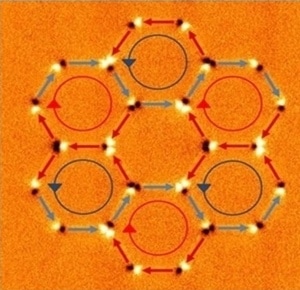Nov 21 2017
Researchers from Imperial College London have developed a new method to write desired magnetic patterns onto nanowires, which could help computers to imitate the way human brain processes information. This new way to write magnetic information could present new opportunities for hardware neural networks.
 Hexagonal artificial spin ice ground state' – a pattern never demonstrated before. Coloured arrows show north or south polarization (Credit: Imperial College London)
Hexagonal artificial spin ice ground state' – a pattern never demonstrated before. Coloured arrows show north or south polarization (Credit: Imperial College London)
Magnetic memory devices are used by many of today’s computer hardware, such as hard drives. These devices depend on magnetic states – the direction pointed by microscopic magnets – to encode and read data.
Unusual magnetic states – such as a point where three south poles meet – denote complex systems. These may behave in a way similar to many complex systems found in nature, for example the way human brains process information.
‘Neural networks’ are referred to computing systems that are developed to process information in ways similar to human brains. Powerful software-based neural networks already exist, for instance one such network recently defeated the human champion at the game ‘Go’. However, these neural networks run on traditional computer hardware and as a result their efficiency is rather limited.
Now, scientists from Imperial College London have developed a new way for writing magnetic information in any desired pattern, using magnetic force microscope – a tiny magnetic probe.
Thanks to this innovative writing method, a range of magnetic nanowires may be able to work as hardware neural networks – probably more efficiently and powerfully than software-based methods.
The researchers, from the Departments of Physics and Materials at Imperial College London, demonstrated their novel system by writing unique patterns that have never been seen before. The results of the study have been reported in Nature Nanotechnology.
With this new writing method, we open up research into ‘training’ these magnetic nanowires to solve useful problems. If successful, this will bring hardware neural networks a step closer to reality.
Dr Jack Gartside, first author from the Department of Physics
In addition to applications in computing, the new method can potentially be used for studying important aspects of complex systems, by generating far from optimal magnetic states (such as three south poles together) and observing the way system responds.
Manipulating miniature magnets may mimic brain processing